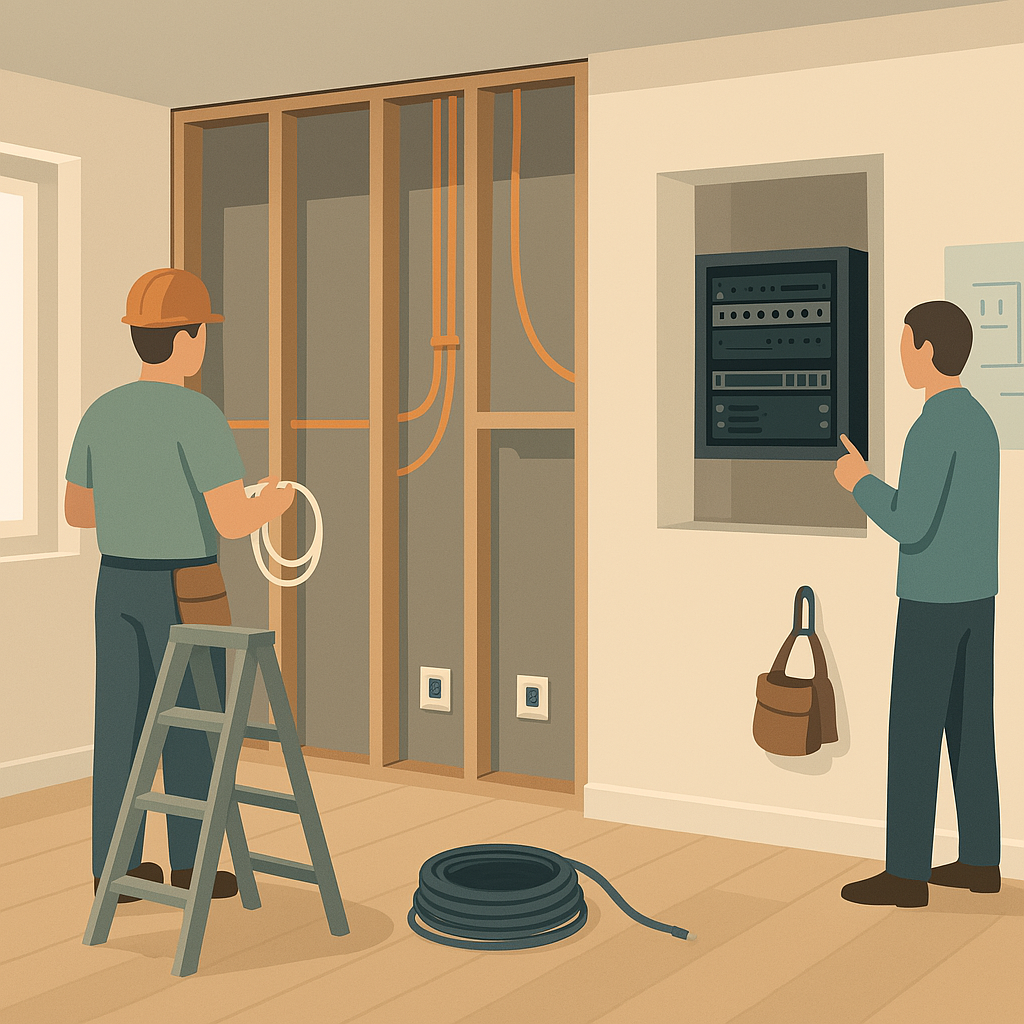Build the Backbone: How to Wire Your Home for Smart Tech That Actually Works

- 1Build the Backbone: How to Wire Your Home for Smart Tech That Actually Works
- 21. Start with Structure, Not Stuff
- 32. What Smart Really Means
- 43. What We Did (And Would Do Again)
- 5Conduits Everywhere
- 6Two Ethernet Jacks Per TV Wall
- 7Ceiling-Mounted Access Points
- 8Outdoor Ethernet Runs
- 9Pre-Wired Doors and Windows
- 10Central Network Hub in a Utility Nook
- 114. How to Copy This Setup (Even on a Budget)
- 12Run Conduit While Walls Are Open
- 13Use Ethernet, Not Just Wi-Fi
- 14Add Outlets in Odd Places
- 15Include Battery Backups
- 165. Avoid These Common Mistakes
- 176. Final Thought: The Best Tech Plan Is a Quiet One
Build the Backbone: How to Wire Your Home for Smart Tech That Actually Works
Don’t chase gadgets. Build the bones.
A truly smart home doesn’t start with devices. It starts with decisions. And the best ones are the kind you don’t notice because they just work.
When we built our custom home, I wasn’t trying to be fancy. I just wanted to avoid future drywall dustThe fine particles created when cutting into finished walls to add wiring or make repairs after construction is complete. So I planned for tech we didn’t even own yet, and that planning has paid off more times than I can count.
This guide walks you through the exact approach I used, so you can wire once and regret less.
1. Start with Structure, Not Stuff
Most people start by buying gadgets: doorbells, thermostats, speakers. But without the right wiring and layout, even the smartest tech turns dumb.
Think of it like building a deck:
- The wiring is the frame.
- The devices are just furniture.
In our house, the frame came first. Before we picked a single smart device, I mapped out where we might need drops in the future. That let me pull wires and drop conduitTubes or pipes installed within walls that allow cables to be pulled through after construction is complete during framing, so we wouldn’t need a SawzallA reciprocating saw commonly used for demolition work, including cutting through walls for retrofitting wiring five years later.
2. What Smart Really Means
“Smart” doesn’t mean flashy. It means:
- Reliable: Works every time, not just when the app loads
- Flexible: Ready to grow without needing a contractor
- Quietly future-ready: Even if you skip the gadgets now, you’ve got the groundwork
For us, that meant putting in the right backbone: conduit, cable runs, outlet locations, even places we weren’t sure we’d need yet.
Take our front porch. We didn’t have a smart doorbell picked out, but I ran EthernetA standard wired networking technology that provides reliable, high-speed data connections between devices to the doorframe just in case. Sure enough, a year later we found one we liked. Install took 10 minutes. No drilling. No patching. Just plug and done.
3. What We Did (And Would Do Again)
In our custom home, I took a layered approach:
ConduitsTubes or pipes installed within walls that allow cables to be pulled through after construction is complete Everywhere
I ran conduit from every major room to the attic and back down to a central hub in our utility nook. I even put conduit in closets and odd corners, places we weren’t sure we’d need now, but didn’t want to cut into later.
Two EthernetA standard wired networking technology that provides reliable, high-speed data connections between devices Jacks Per TV Wall
One for the TV. One for whatever comes next. In one room, it became a gaming console. In another, a hardwired streaming box. In a third? Still waiting but it’s there when we need it.
Ceiling-Mounted Access PointsDevices that create a wireless network (WiFi) connection point, typically offering better coverage than a standard router
We live in the mountains with spotty cell service, so I wired our house for ceiling-mounted Wi-FiWireless networking technology that allows devices to connect to the internet without physical cables. Indoors and out. These keep our video calls strong and our daughter’s schoolwork flowing, even when the weather cuts cell towers.
Outdoor Ethernet Runs
Yes, even outside. I ran lines to the porch, patio, and yard. Now we can have outdoor speakers, a camera feed to the driveway, and full signal on the riding mower (ask me how I know).
Pre-Wired Doors and Windows
Ethernet to the front and side doors gave us freedom to add cameras and doorbells later, without figuring out how to run power to a brick wall.
Central Network Hub in a Utility Nook
Every cable run terminates to a compact media nookA dedicated space designed to house and organize networking equipment, typically recessed into the wall with a small 6U rackA standardized frame for mounting multiple pieces of electronic equipment, where U (unit) is a measure of vertical space (1U = 1.75 inches). My switchA networking device that connects multiple devices together on a local network, routerA device that forwards data packets between computer networks, typically connecting your home network to the internet, UPSUninterruptible Power Supply, a battery backup system that keeps equipment running during power outages, and patch panelA mounted hardware assembly that houses cable connections, making it easier to organize and manage network connections sit neatly under a shelf. It’s not glamorous, but it’s cool, quiet, and easy to access when upgrades come calling.
4. How to Copy This Setup (Even on a Budget)
Run Conduit While Walls Are Open
- Use 3/4” or 1” PVC or flexible conduitBendable tubing that allows for easier installation around corners and obstacles compared to rigid conduit
- Pull strings through as you install so future wire runs are simple
- Terminate everything to a central location
Use Ethernet, Not Just Wi-Fi
Wi-Fi is convenient. But wired is still:
- Faster
- More reliable
- Less annoying when you’re mid-Zoom call
Cat6AAn enhanced network cable that supports speeds up to 10 Gbps and reduces interference is plenty for home use. I installed it everywhere I thought we’d need it and a few places I wasn’t sure we would. Guess what? We’ve used more drops than I planned.
Add Outlets in Odd Places
- High corners (future cameras)
- Closets and pantries (routers, vacuums, charging stations)
- Behind TVs, on stair landings, in attics, and at desk height
We even put one in the coat closet. It powers a hidden vacuum charger and a Wi-Fi plug-in hubA device that connects to your Wi-Fi network and allows you to control multiple smart devices through a single interface. Super handy.
Include Battery Backups
A small UPSUninterruptible Power Supply, a battery backup system that keeps equipment running during power outages on your switch and router keeps the internet alive during power dips. We get wind storms and brownoutsA temporary reduction in electrical power that can cause equipment to malfunction or shut down where we live, and ours has saved many a remote work day.
5. Avoid These Common Mistakes
- Only wiring for today’s needs: Your home will outlast your gadgets
- Stuffing tech gear into tight closets: Leave space and airflow
- Skipping labels: If you don’t label your cables now, you’ll be pulling hair later
- Assuming wireless will solve everything: It won’t. Even Wi-Fi needs good bones
6. Final Thought: The Best Tech Plan Is a Quiet One
The best kind of smart home? One that just works.
And the best time to plan it is before the drywall goes up. Even if you don’t install a single smart gadget now, you’ll be wired for anything later.
So before you pick out the smart fridge, plan your conduits. Before you hang the TV, check your cable runs. And before you start shopping, ask:
“Will future-me thank me for this?”
Because when the next big thing comes along, all you’ll need is a screwdriver, not a contractor.
Want help thinking it through? Book a coaching call, or join the HouseChalk community where we can trade tips, setups, and wiring wins that make homes actually smart, without the stress.
